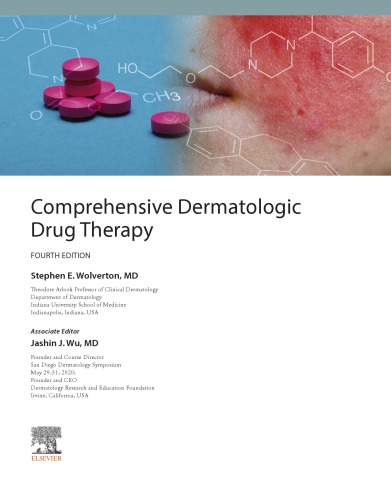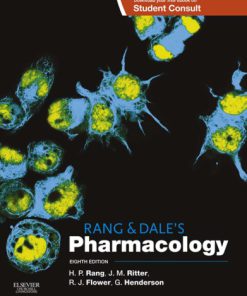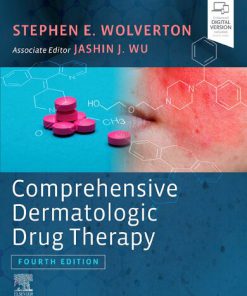Comprehensive Dermatologic Drug Therapy 4th Edition by Stephen Wolverton, Jashin Wu 9780323612548 0323612547
$50.00 Original price was: $50.00.$25.00Current price is: $25.00.
Comprehensive Dermatologic Drug Therapy 4th Edition by Stephen Wolverton, Jashin Wu – Ebook PDF Instant Download/Delivery: 9780323612548, 0323612547
Full dowload Comprehensive Dermatologic Drug Therapy 4th Edition after payment

Product details:
• ISBN 10:0323612547
• ISBN 13:9780323612548
• Author:Stephen Wolverton, Jashin Wu
Designed with practical usability in mind, Comprehensive Dermatologic Drug Therapy, 4th Edition, helps you safely and effectively treat the skin disorders you’re likely to see in your practice. Dr. Stephen E. Wolverton and new associate editor Dr. Jashin J. Wu lead a team of global experts to bring you concise, complete guidance on today’s full spectrum of topical, intralesional, and systemic drugs. You’ll prescribe with confidence thanks to expert coverage of which drugs to use, when to use them, and adverse effects to monitor.
Comprehensive Dermatologic Drug Therapy 4th Table of contents:
Part I. Introduction
1. Basic Principles of Pharmacology
Introduction
Pharmacokinetics—Part I (Tables 1.2 and 1.3)
Pharmacodynamics (The Drug Produces the Desired Pharmacologic Effect)
Pharmacokinetics—Part II
Percutaneous Absorption
Summary
2. Principles for Maximizing the Safety of Dermatologic Drug Therapy
Introduction
Anticipation
Prevention
Diagnosis
Management
Parting Thoughts
3. Polymorphisms: Why Individual Drug Responses Vary
Introduction
Evaluating the Patient
Factors That Influence Medication Effects (Including Adverse Effects)
Drug Metabolism—Phase I Reactions
Drug Metabolism—Phase II Reactions (TABLE 3.9)
Tests for Genetic Polymorphisms and Clinical Significance
Pharmacogenomic Databases
Conclusions and Future Directions
4. Adherence to Drug Therapy
Introduction
Measures of Adherence
The Magnitude of Poor Adherence in Dermatology
Factors that Influence Adherence Behavior
Strategies to Improve Adherence Behavior
Conclusions
5. Medical Decision Making
Introduction
Patient Individualization and Prioritization (Box 5.1)
Medical Decision Making (Box 5.2)
Causation Determination (Box 5.3)
Evaluating the Medical Literature (Box 5.4)
Interpretation of Medical Literature (Box 5.5)
Prescriber Responsibilities (Box 5.7)
Longitudinal Patient Care Decisions (Box 5.8)
Decision-Making Realities (Box 5.9)
Part II. Important Drug Regulatory Issues
6. The FDA Drug Approval Process
Introduction
Federal Legislation for Drug Safety and Efficacy
Phase I to IV Testing
US Food and Drug Administration Advisory Panels
Off-Label Drug Use
Generic Drugs
Special Drug Approval Categories
Related Issues
7. Pharmacovigilance: Verifying that Drugs Remain Safe
Introduction
Summary
8. Drugs Taken Off the Market: Important Lessons Learned
Introduction
Presentation of Risk–Benefit in Labeling
Product Label ‘Lifecycle’ Changes
Risks and Benefits: US Food and Drug Administration Safety Information
Drug Withdrawal
Part III. Systemic Drugs for Infectious Diseases
9. Systemic Antibacterial Agents
Introduction
Penicillins
Cephalosporins
β-Lactam and β-Lactamase Inhibitor Combinations
Other Systemic Antibacterials that Inhibit Cell Wall Synthesis
Macrolides
Fluoroquinolones
Tetracyclines
Rifampin and Other Rifamycins
Folate Synthesis Inhibitors
Lincosamides
Oxazolidinones
Special Topics
10. Systemic Antifungal Agents
Introduction
Mechanism of Action
Conclusion
11. Systemic Antiviral Agents
Introduction
Drugs for Human Herpes Virus Infections
Drugs for Human Immunodeficiency Virus Infections
Therapeutic Guidelines—Drugs for Human Immunodeficiency Virus Infections
Summary
12. Systemic Antiparasitic Agents
Ivermectin
Albendazole
Thiabendazole
Alternative Agents—Doxycycline As Antiparasitic Agent
Part IV. Systemic Immunomodulatory Drugs
13. Systemic Corticosteroids
Systemic Corticosteroids
Pharmacology (Table 13.1)
Clinical Use
14. Methotrexate
Introduction
Pharmacology
Clinical use
15. Azathioprine
Introduction
Pharmacology
Clinical Use
Summary
16. Mycophenolates
Introduction
Pharmacology
Mechanisms of Action
Clinical Use
Off-Label Dermatologic Uses
Immunobullous Disease
Autoimmune Connective Tissue Disease
17. Cyclosporine
Introduction
Summary
18. Phosphodiesterase-4 and Janus Kinase Inhibitors
Introduction
Small Molecule Treatments
Mechanism of Action of Phosphodiesterase 4 Inhibition
Phosphodiesterase 4 Inhibitor Therapy
Janus Kinase Inhibitors
Conclusion
19. Cytotoxic Agents
Introduction
Major Subcategories of Cytotoxic Agents and the Cell Cycle
Patient Education Issues
Antimetabolites
Alkylating Agents
20. Dapsone
Introduction
Pharmacology
Clinical Use
21. Antimalarial Agents
Introduction
Pharmacology
Clinical Use
Other Potential Benefits
Monitoring Guidelines84–86,125
Drug Interactions
Therapeutic Guidelines
22. Systemic Retinoids
Introduction and Historical Perspective
Pharmacology
Clinical Use
Part V. Drugs Used in Conjunction with UV or Visible Light
23. Psoralen Plus Ultraviolet A Photochemotherapy and Other Phototherapy Modalities
Introduction
Psoralen Plus Ultraviolet A Photochemotherapy
Narrow-Band Ultraviolet B Phototherapy
Targeted Phototherapy
Uva-1 Phototherapy
24. Extracorporeal Photochemotherapy (Photopheresis)
Introduction
Treatment Delivery and Considerations
Pharmacology
Clinical Use
25. Photodynamic Therapy
Introduction
Pharmacology
Clinical Use
Part VI. Biologic Therapeutics
26. Tumor Necrosis Factor Inhibitors
Introduction—Psoriasis Pathogenesis
Etanercept
Infliximab
Adalimumab
Certolizumab Pegol
27. Interleukin 12/23 Inhibitors
Introduction
Monoclonal Antibody Treatments
Interleukin-12/23 Therapy – Ustekinumab
Conclusions
28. Interleukin 17 Inhibitors
Introduction
Secukinumab
Ixekizumab
Brodalumab
Common Adverse Events Among All IL-17 Inhibitors
Summary
29. Interleukin 23 Inhibitors
Introduction
US Food and Drug Administration Approval
Guselkumab
Tildrakizumab
Risankizumab
Future IL-23 Inhibitors for Psoriasis
Conclusion
30. Rituximab
Introduction
31. Additional Biologic Therapeutics: Dupilumab, Omalizumab, Others
Dupilumab
Omalizumab
Other Biologic Therapies in Development
Part VII. Miscellaneous Systemic Drugs
32. Antihistamines
Historical Overview
First-Generation Antihistamines
Second-Generation H1 Antihistamines
H1 Antihistamine in Pregnancy and Lactation
H2 Antihistamines
Tolerance (Tachyphylaxis and Subsensitivity)
Oral and Topical Doxepin
Antihistamine Therapy of Chronic Urticaria and Angioedema
Antihistamines for Atopic Dermatitis
33. Vasoactive and Antiplatelet Agents
Pathophysiology Involving Cutaneous Vasculature
Calcium Channel Blockers
β-Blockers
Aspirin
Dipyridamole (Box 33.4)
Pentoxifylline (Box 33.5)
Nitric Oxide Donors
Phosphodiesterase-5 Inhibitors
Iloprost
Antiangiogenesis Agents
34. Antiandrogens and Androgen Inhibitors
Introduction
Physiologic Role of Androgens
Antiandrogens
Androgen Inhibitors
Hormone Preparations
Gonadotropin-Releasing Hormone Analogs
Herbal and Experimental Therapies
35. Psychotropic Agents
Introduction
Classification of Psychodermatologic Disorders
The Management of Anxiety in Dermatology
The Management of Depression in Dermatology
Alternatives to Selective Serotonin Reuptake Inhibitor Antidepressants
The Management of Delusional Disorders in Dermatology
36. Intravenous Immunoglobulin Therapy
Introduction
37. Systemic Anticancer Agents: Dermatologic Indications and Adverse Events
Introduction
Epidermal Growth Factor Receptor Inhibitors
Multitargeted Kinase Inhibitors
Alkylating Agents
Topoisomerase Inhibitors
Antimicrotubule Agents (Taxanes)
Anthracyclines
Histone Deacetylase Inhibitors
Miscellaneous
Monoclonal Antibodies
Antimetabolites
Biotherapy (Immunokines)
PD-1 Inhibitors
Braf Inhibitors
Summary
38. Hedgehog Pathway Inhibitors
Introduction
Pharmacology
Clinical Use
Off-Label Dermatologic Uses
Adverse Effects
Drug Interactions
Monitoring Guidelines
Other Hedgehog Inhibitors
39. Drugs for the Skinternist
Introduction
Therapy for Corticosteroid-Induced Osteoporosis
Bexarotene for Cutaneous T-Cell Lymphoma—Central Hypothyroidism
Therapy for Retinoid- or Cyclosporine-Induced Hyperlipidemia
Fibric Acid Derivatives
Corticosteroid-Associated Peptic Ulcer Disease
Vitamin D Therapy
40. Miscellaneous Systemic Drugs
Introduction
Anticholinergic Agents—Glycopyrrolate and Oxybutynin
Attenuated Androgens—Danazol
Biotin
Clofazimine
Colchicine
Fumaric Acid Esters
Niacinamide
Nonsteroidal Anti-inflammatory Drugs
Penicillamine
Potassium Iodide
Thalidomide
Vitamin E
Zinc Sulfate
Part VIII. Topical Drugs for Infectious Diseases
41. Topical Antibacterial Agents
Introduction
Drugs Used for Wound Care and Minor Topical Bacterial Infections
Drugs Used for Acne and Rosacea
Antiseptics
42. Topical Antifungal Agents
Introduction
Polyenes
Azoles
Allylamines and Benzylamines
Other Topical Antifungals
Comparative Studies
43. Topical and Intralesional Antiviral Agents
Introduction
Viricidal Drugs
Immune-Enhancing Drugs
Cytodestructive Drugs
44. Topical Antiparasitic Agents
Introduction
Permethrin and Pyrethrins
Ivermectin—Topical (Table 44.3)
Malathion (Table 44.4)
Spinosad (Table 44.5)
Crotamiton
Benzyl Benzoate
Precipitated Sulfur
Lindane
Melaleuca Alternifolia (Tea Tree) Oil
Nonpharmacologic Therapy for Head Lice
Miscellaneous Antiparasitic Agents
Part IX. Topical Immunomodulatory Drugs
45. Topical Corticosteroids
Introduction
Pharmacology
Clinical Use
Adverse Effects—Systemic
Adverse Effects—Local
Therapeutic Guidelines
46. Topical Retinoids
Introduction
Pharmacology
Clinical Use
47. Topical and Intralesional Chemotherapeutic Agents
Introduction
Topical Chemotherapeutic Agents
Intralesional Chemotherapeutic Agents
48. Topical Calcineurin Inhibitors
Introduction
Tacrolimus
Pimecrolimus
49. Topical Vitamin D3
Introduction
Pharmacology
Vitamin D Analogs
Calcipotriene—Clinical Use
Part X. Miscellaneous Topical Drugs
50. Sunscreens
Introduction
Sunscreen Options
Clinical Use
Summary
51. Therapeutic Shampoos
Introduction
Dermatoses Involving the Scalp
Clinical Use
Therapeutic Guidelines
Summary
52. α-Hydroxy Acids
Introduction
Pharmacology
Clinical Use
Formulations and Bioavailability
Safety and Adverse Effects
Summary
53. Chemical Peels
Introduction
Superficial Chemical Peels
Medium-Depth Chemical Peels
Deep Chemical Peels
54. Products for the Care of Chronic Wounds
Introduction
Wound Healing Physiology and Ideal Wound Healing Environment
General Approach to a Patient with Chronic Wounds
Venous Ulcer Disease
Systemic and Surgical Treatments
55. Agents Used for Treatment of Hyperkeratosis
Introduction
Salicylic Acid
56. Irritants and Allergens: When to Suspect Topical Therapeutic Agents
Introduction
Contact Dermatitis: the Concept
When to Suspect Contact Dermatitis
Final Thoughts
57. Miscellaneous Topical Agents
Introduction
Topical Antioxidants
Topical Agents for Hemostasis and Hyperhidrosis
Other Topical Agents
Part XI. Injectable and Mucosal Routes of Drug Administration
58. Local Anesthetics
Introduction
Injectable Local Anesthetics
Topical Anesthetics
Coinjectable Vasoconstrictors
Other Agents with Local Anesthetic Effects
59. Injectable Dermal and Subcutaneous Fillers
Introduction
Categories of Dermal Fillers
Autologous Human Fibroblasts
Fillers on the Horizon
Adverse Effects
60. Botulinum Toxin Injections
Introduction and History
Conclusions
61. Oral Mucosal Therapeutics
Introduction
Review of Common Terminology
Erosive Gingivostomatitis
Herpetic Gingivostomatitis
Oral Candidiasis
Hairy Tongue
Recurrent Aphthous Stomatitis
Acute Necrotizing Ulcerative Gingivostomatitis
Mucositis (Stomatitis)
Xerostomia
Burning Mouth Syndrome
Part XII. Major Adverse Effects From Systemic Drugs
62. Hepatotoxicity of Dermatologic Drug Therapy
Introduction
The Liver and Drug Metabolism
Mechanisms of Drug Hepatotoxicity
Risk Factors for Drug Hepatotoxicity
Drug Information Dissemination Issues
Classification Systems
Drug Etiologies
Diagnosis
Management
Looking to the Future—Lessons from the Past
63. Hematologic Toxicity of Drug Therapy
Introduction
General Principles
Major Categories of Drug-Induced Hematologic Toxicity
Drugs Prescribed by Dermatologists—Risk of Hematologic Toxicity
Treatment of Hematologic Toxicities
64. Drug-Induced Malignancy
Introduction
Assessment of Drug Causation for Malignancy Induction
General Principles of Carcinogenesis
Review of Malignancy Risk with Organ Transplantation
Review of Malignancy Risk with Autoimmune Diseases
Specific Drugs Used in Dermatology and their Potential Risk for Malignancy
Prevention and Detection of Possible Malignancies
The Bottom Line
65. Dermatologic Drugs During Pregnancy and Lactation
Introduction
General Principles
Guide for Specific Drug Use
Summary
66. Drug Interactions
Introduction
General Principles of Drug Interactions
Cytochrome P-450–Based Drug Interactions
Importance of the Order of Drug Administration
Drug Interactions with Drugs that Increase QTc Intervals
Drug Interaction Risks by Drug Category
Genetic Polymorphisms
Pharmacodynamic Mechanisms of Drug Interactions
Do All Drugs in a Given Class Behave in a Similar Manner?
Summary
67. Cutaneous Drug Reactions With Systemic Features
Introduction
Serum Sickness and Serum Sickness-Like Reactions
Drug-Induced Lupus
Acute Generalized Exanthematous Pustulosis
Stevens-Johnson Syndrome and Toxic Epidermal Necrolysis
General Discussion
Part XIII. Special Pharmacology and Therapeutics Topics
68. Informed Consent and Risk Management
Introduction
Historical Perspective
Ethical Perspective
Basic Legal Principles
Components of Informed Consent
Systemic Drugs and Informed Consent
Optimizing Patient Understanding
Exceptions to the Informed Consent Requirements
Medicolegal Risk Management
Dermatology Malpractice
Summary
69. Compounding in Dermatology
Introduction
The Compounding Triad
Developing a Stable Compounding Formula
Properly Write the Prescription
Monitor the Patient
Summary
70. Dermatologic Drug Therapy in Children
Introduction
Pediatric Considerations for Commonly Used Medications
Systemic Retinoids
Systemic Immunosuppressive Therapies
Appendix I. Core Questions for Understanding Systemic Dermatologic Drugs
Appendix II. The Most Potentially Serious Drug Interactions
Index
People also search for Comprehensive Dermatologic Drug Therapy 4th:
comprehensive dermatologic drug therapy
comprehensive dermatologic drug therapy pdf
wolverton comprehensive dermatologic drug therapy
comprehensive dermatologic drug therapy 4th edition
comprehensive dermatologic drug therapy fourth edition
You may also like…
History & Research
A Comprehensive Guide to Music Therapy Stine Lindahl Jacobsen
Uncategorized
Medicine - Radiology
Politics & Philosophy - Social Sciences
Medicine
Principles of Pharmacology: The Pathophysiologic Basis of Drug Therapy 4th Edition David E. Golan
Medicine - Radiology












